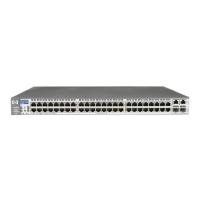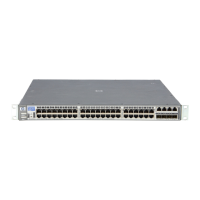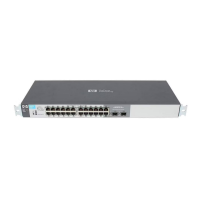Configuring the Switch Modules using the Menu-driven Interface
Configuring Port Trunking
This section describes how to configure port trunking. For information on how to set the
trunk load sharing algorithm parameter, refer to the “Configuring Advanced Switch Module
Features” section earlier in this chapter.
Port trunking allows several ports to be grouped together to act as a single link. This provides
a bandwidth that is a multiple of a single link bandwidth. Port trunking is most commonly
used to link a bandwidth-intensive network device or devices, such as a server, to the
backbone of a network.
The switch module allows the creation of up to six port trunk groups, each group consisting
of up to eight links (ports). HP recommends that the port trunk ports be members of the same
VLAN. Only similar type ports can be members of port trunks. A combination of Fast
Ethernet (FE) and Gigabit (GE) ports cannot be members of the same port trunk.
The configuration of the lowest numbered port in the group becomes the configuration for all
of the ports in the trunk group. This port is called the master port of the trunk group, and all
configuration options, including the VLAN configuration, which can be applied to the master
port, are applied to the entire port trunking group.
Load balancing is automatically applied to the ports in the trunked group, based on the setting
of the trunk load-sharing algorithm, and a link failure within the group causes the network
traffic to be directed to the remaining links in the group.
Spanning Tree Protocol treats a port trunking group as a single link on the switch module
level. STP uses the port parameters of the master port in the calculation of port cost and in
determining the state of the port trunking group. If two redundant port trunking groups are
configured on the switch module, STP blocks one entire group, similar to STP blocking a link
in case of two redundant links.
Considerations when Creating a Port Trunking Group
When creating a port trunking group, consider the following rules that determine how the port
trunk reacts in network topology:
•
•
•
•
•
The first port of the port trunk is implicitly configured to be the master logical port. This
is the reference port used in configuration commands. It can be thought of as the logical
port representing the entire group.
When using a port trunk, always reference the master logical port of the group when
configuring or viewing VLANs.
VLANs configured to use other ports in the port trunk will have those ports deleted from
the VLAN when the port trunk becomes enabled.
The Spanning Tree algorithm views port trunk as a single Spanning Tree port. The
Spanning Tree port is represented by the master logical port.
If the VLAN settings of the master logical port are changed, the VLAN settings of all
members of that port trunk are changed similarly.
HP ProLiant BL e-Class C-GbE Interconnect Switch Menu-driven Interface Reference Guide 2-35
HP CONFIDENTIAL Codename: DeLorean Part Number: 322858-001 Last Saved On: 2/4/03 11:56 AM

